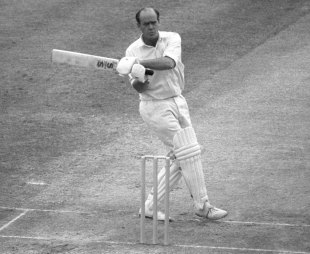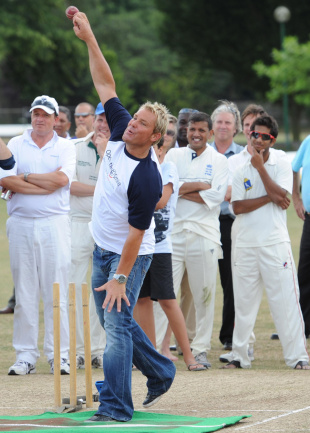Art and graft
Mike Atherton

| |||
Boy, he looked good. Sitting there in his crisp, grey suit, hair slicked back, tanned, square of jaw, he looked as if he could have played for another decade. But Mark Ramprakash had decided enough was enough. The runs had not flowed with their customary ease and, midway through his 26th summer in the first-class game, it was time to reflect on what had gone, rather than speculate about what was to come.
Rightly, the valedictories were gushing. This was a batsman, after all, who had scored over 35,000 first-class runs at an average of 53, and joined the elite group of those who have made more than 100 first-class hundreds. Because of the impact an expanded international game has had on appearances in domestic cricket, he could well be the last member of the club. At every level except the very top, he made batting look easy. He was a fine player.
Many pieces were written about Ramprakash in the days after his retirement, and many included the phrase "the most talented player of his generation". A few suggested his talent was unfulfilled, which seemed a little harsh, even if it reflected his travails in over a decade of Test cricket. The implication was that he had underperformed, a view based on a perception of the ability he was blessed with.
Talent. We have a curious relationship with it in English cricket. If it is generally defined as possessing either a natural gift, or a capacity for success, then our game invariably tags as talented those who enjoy the gift, but not necessarily the success. Many England cricketers who have struggled to establish themselves in the international game - Chris Lewis, Mark Lathwell, Owais Shah and Ravi Bopara, to name four recent examples - are routinely described as being among the most talented players of their time.
The notion of a natural gift has taken a battering in recent years, thanks in particular to the work of one scientist. The Swedish psychologist K. Anders Ericsson has gone a long way towards deconstructing the myths of talent by showing that elite performance is almost always the result of ferocious hard work, relentless self-improvement and specific, rigorous practice - all within a cultural context in which the appetite for self-improvement can flourish. In other words, few have reached the top without putting in the hours.
Ericsson's work is now widely accepted, but there are still some who believe in inherent or inheritable gifts. For sports such as basketball, which require genetically linked physical advantages, it is hard not to sympathise with this view. But whichever side of the divide you tread, it should be obvious that the term tends to be applied retrospectively. In describing someone as talented, we do not really mean they have some innate predisposition to perform; rather, it is a convenient way of explaining their achievements (or even, in English cricket, their shortcomings).
In looking for examples of talent, we nearly always exaggerate the importance of an eye-catching moment, or a graceful style. Aesthetics outweigh almost everything else. Ramprakash's feats were far from modest, but it was his elegance - the ease with which he appeared to play, the extra time he appeared to enjoy - that encouraged the notion he was unusually talented.
Very few observers, by contrast, would describe South Africa's Graeme Smith as naturally gifted. With his wide, ungainly stance, strangling grip, and closed-face back-lift, he makes batting look hard work. And yet his method makes perfect sense. In an era where bowling at fourth stump is accepted practice, and when fielders in the arc between wicketkeeper and point often outnumber the rest, Smith's refusal to hit in areas traditionally regarded as left-handers' strengths gives him an advantage. More than 8,500 Test runs at nearly 50 as an opening batsman suggest he possesses talents that transcend mere aesthetics (or their absence).
Most of us are prone to this weakness of falling for the kind of talent that a moment of brilliance implies: a breathtaking stroke, a scintillating piece of fielding. As a result, we underestimate the gifts given to those who achieve consistently, if not spectacularly. After watching a young Dwayne Smith, the West Indian all-rounder who had made a rapid century on Test debut, smash a length ball from Steve Harmison over midwicket and out of the ground in Trinidad some years ago, I turned to my companion and said: "I've just seen the next great West Indian batsman." One shot was enough to fool me. All through the disappointing years that followed, I kept expecting what I thought was exceptional talent to blossom. It never did.
We are apt to hold too narrow a definition of what constitutes talent. One of Ramprakash's contemporaries was Graham Thorpe. More than a decade ago in Colombo, I watched him score a hundred against Sri Lanka's spinners in conditions that could not have been more testing, with the sun beating down and the pitch disintegrating into dust. His strokeplay was not eye-catching; in fact, the innings was devoid of any flowing shots at all. But what an innings it was - one of the finest I ever saw from an England player.
That day, Thorpe revealed so many different aspects of his talent. He played the ball off the pitch later than any of his team-mates. It takes a particular gift to let the ball keep coming and coming until the bowler is almost yelping with success, but he adopted a kind of French-cricket technique, keeping his back-lift low, and turning the blade with his wrists at the last moment to pierce gaps that most others would have needed satellite navigation to find. His talent was to adapt to his surroundings. As for my own career, I take an innings of 99 at Headingley against South Africa in 1994 as one that revealed my own special - for want of another word - talent. It was after the dirt-in-the-pocket match at Lord's and, in the intervening week, I had to cope with an unusual degree of public interest, with a tabloid tracking my every movement. Between Tests, I had not been able to practise, and there had been no county match for Lancashire.
The attention was not on my batting, but on my captaincy and character. I had been forced to sit through two torturous televised press conferences, and to listen to a range of critics, from the comedian Jimmy Tarbuck to the chairman of the Headmasters' Conference, who sought my resignation. It was an uncomfortable time, and before I walked out to bat, I had not given a moment's thought to the innings. I scratched around for a couple of hours before lunch, and forced myself into some kind of rhythm by dint of nothing more than pure bloody-mindedness. But what I had managed to do, between walking to the middle and facing the first ball, was to put the events of the previous fortnight to the back of my mind. I am certain that, in the same circumstances, not many of my contemporaries could have played that innings, that day.
The ability to shut out the noise and the clamour is something I see now - to a far greater degree - in Alastair Cook. It is not an aptitude that stands out, is easily recognised, or regarded as exceptional. Hidden from view it may be but, set against the requirements for success at international level, with all its pressures, it is a talent as important as the ability to play a good-looking cover-drive. It is only now, after over 7,000 Test runs and more hundreds than any other England player, that observers (I have been more guilty than most) are starting to think of him as gifted.
Barring injury, illness or misfortune, Cook - who is only just entering his prime - will probably become the greatest batsman England have ever produced; greatest, that is, in terms of run-scoring, record-breaking and hundred-making. The adjectives that accompany most of his innings are hard-working, focused, driven, effective, pragmatic - as if these attributes, and Cook's supreme thirst for self-improvement, are not identifiable talents in themselves.
They are submerged beneath a game that sometimes stands out only for its ordinariness. Yet Andy Flower has commented upon his world-class facility to score through the leg side and off his hip, a gift those at Essex quickly recognised; his ability to shut out extraneous detail, and his concentration levels, speak of a particular talent too. The way he out-thought and outmanoeuvred India's spinners during consecutive hundreds in Ahmedabad, Mumbai and Kolkata over the winter revealed a cricketing intelligence not shared by many of his team-mates. His hundred in Mumbai was certainly less spectacular than Kevin Pietersen's, but can we really say Cook is less talented? He simply possesses different strengths.
Talent may or may not be innate but, in all its facets, it certainly exists to be developed, honed and crafted. The more humdrum aspects of the game - the ability to work hard, stay focused, adapt to circumstance, bring your best game to the crease time and again, despite all the distractions - are all gifts, just as much as sweet ball-striking.
One of the sweetest strikers in the English game right now is Bopara. The consensus is that he is more naturally gifted than Cook but, as he sat at home over the winter, watching him compile hundred after hundred, how Bopara must have wished for some of his talents - the ability, for example, to put a run of bad scores behind him, or to compile the kind of ugly runs that would keep him in the team from one game to the next until form returns, as Cook did memorably against Pakistan at The Oval in 2010.
In one of his more poetic moments, Friedrich Nietzsche said: "All great artists and thinkers are great workers, indefatigable not only in inventing but also in rejecting, sifting, transforming and ordering." Cook is indefatigable in ordering his gifts, but no doubt it will be his Essex team-mates, Shah and Bopara, who are remembered as the more talented.
Being tagged as supremely talented also diminishes Ramprakash's achievements, because the implication is that the game came easily to him. If it looked that way, it was on the back of unstinting hard work. Having played with him for over a decade, I would not disagree with anybody who called Ramprakash the most dedicated batsman of his generation. As for the most talented? Well, that depends on your definition.



